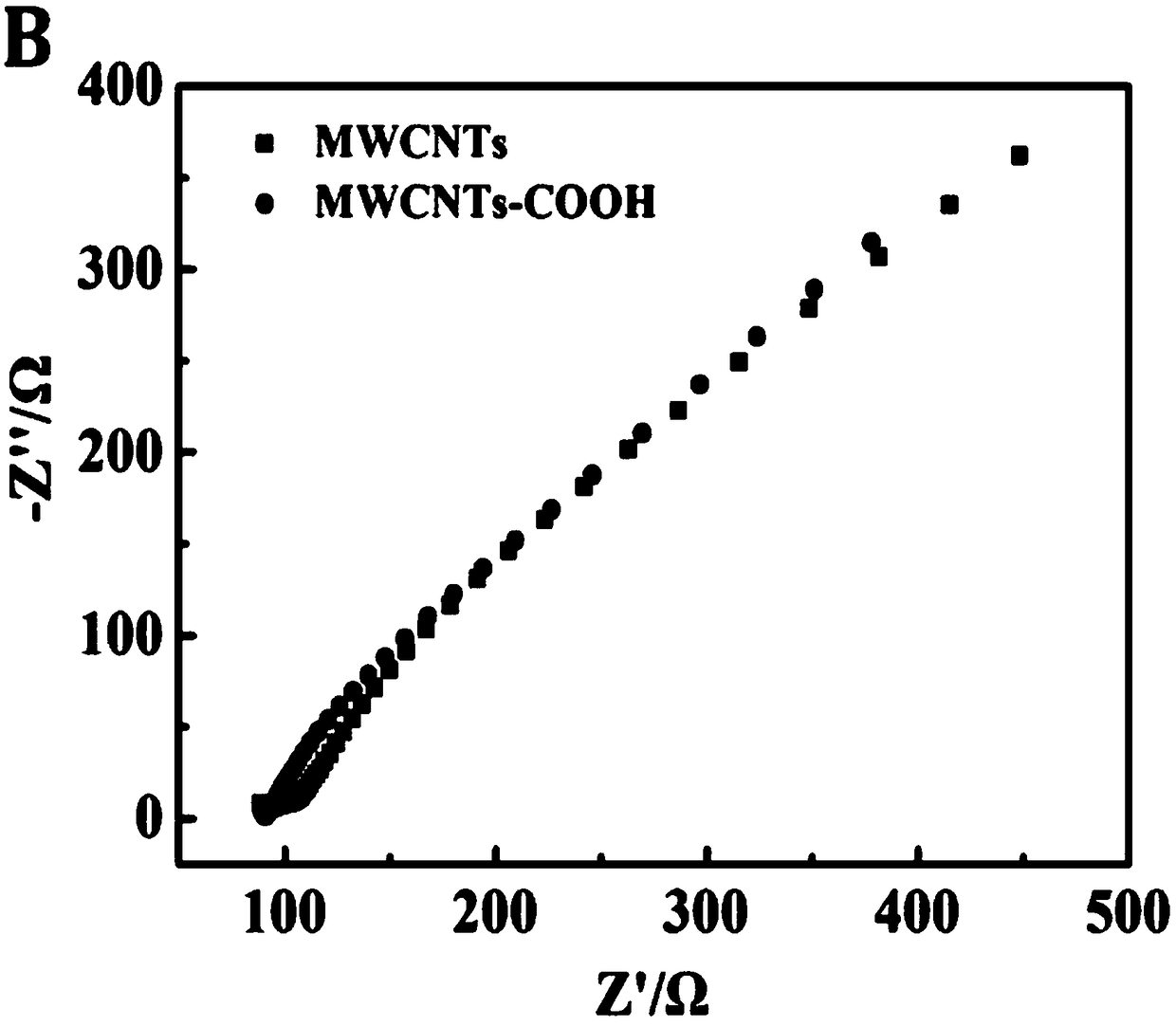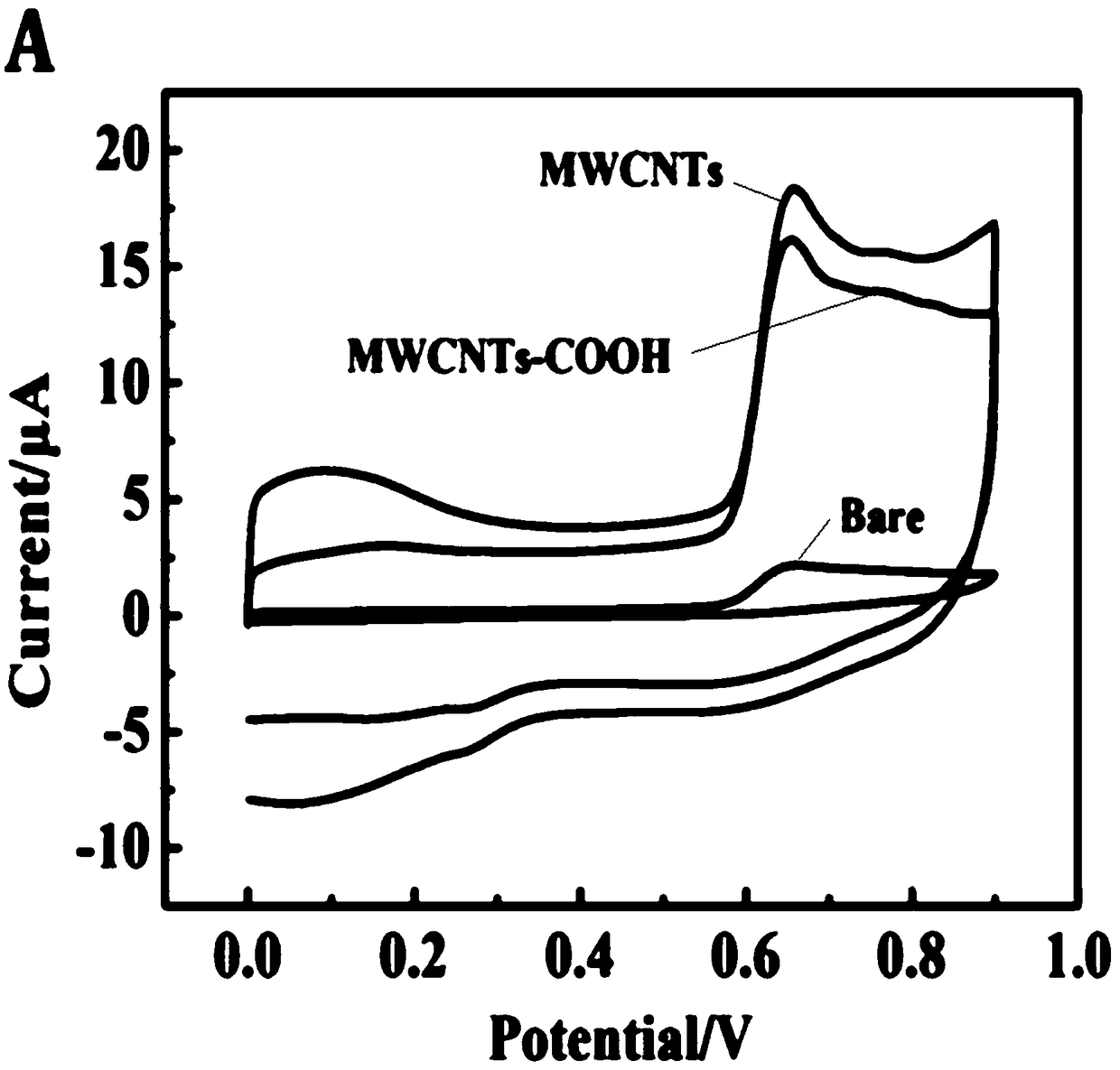Electrochemical sensor based on carbon nanotube and preparation method and application thereof
A carbon nanotube and multi-walled carbon nanotube technology, which is applied in the fields of environmental analysis and electroanalytical chemistry, can solve the problems of simultaneous analysis and detection of bisphenol A and bisphenol S, etc., and achieve ultra-high specific selectivity, reducing The effect of low matrix interference, efficient analysis
- Summary
- Abstract
- Description
- Claims
- Application Information
AI Technical Summary
Problems solved by technology
Method used
Image
Examples
preparation example Construction
[0026] The invention describes a method for preparing an electrochemical sensor based on carbon nanotubes, which is characterized in that: it comprises the following steps:
[0027] (1) Dissolving 0.5-4mg of multi-walled carbon nanotube MWCNTs powder in 0.5-4mL of N,N-dimethylformamide, ultrasonic treatment for 0.5-4h, to form a uniform suspension;
[0028] (2) Polish the surface of the glassy carbon electrode GCE with 0.02-0.2 μM alumina solution, ultrasonically treat it in absolute ethanol and aqueous solution for 0.5-5 min, wash the polished electrode, and clean it with high-purity N 2 Blow dry to get bare glassy carbon electrode Bare-GCE;
[0029] (3) Bare-GCE, Ag / AgCl electrodes and Pt electrodes are immersed in [Fe(CN)6] containing 0.5-5mM volume ratio of 1:1 3- / 4-Perform a linear cyclic voltammetry scan in a solution of 0.02-0.5M KCl, and when the cyclic voltammetry curve with a potential difference lower than 75mV is obtained, the electrode can be used as the subst...
Embodiment 1
[0044] The anti-interference ability of the invented electrochemical sensor based on carbon nanotubes was evaluated. In this experiment, the invented electrochemical sensor based on carbon nanotubes was used as the working electrode, and the differential pulse voltammetry (DPV) was used to test the There may be interfering phenolic organic compounds such as catechol (CL, 100 μM) and hydroquinone (HQ, 100 μM). The result is as image 3 As shown, CL and HQ have oxidation peaks at 0.188 and 0.092V, and the oxidation peak potential difference of bisphenol A (0.472V) and bisphenol S (0.736V) is greater than 0.2V. The detection of bisphenol A and bisphenol S None of the signals were affected by it, indicating that the invented carbon nanotube-based electrochemical sensor has good selectivity for the detection of bisphenol A and bisphenol S.
Embodiment 2
[0046] The linear range and detection limit of the invented electrochemical sensor based on carbon nanotubes for bisphenol A and bisphenol S were evaluated. Use the invented electrochemical sensor based on carbon nanotubes to simultaneously measure bisphenol A and bisphenol S. The concentration of one substance is fixed at 50 μM, and the concentration of the other substance is changed. Observe whether the measurement interferes with each other. The results are shown in Figure 4 . Fig. 4A is the DPV curve obtained on the inventive electrochemical sensor based on carbon nanotubes when different concentrations of BPA are mixed with a certain concentration of BPS (50 μM). It can be known from this curve that adding different concentrations of BPA, BPS The peak currents of α remained almost constant, which indicated that the sensor had good resolving performance for these two substances. As shown in Figure 4B, Ip and BPA have a good linear relationship in the concentration range o...
PUM
 Login to View More
Login to View More Abstract
Description
Claims
Application Information
 Login to View More
Login to View More - R&D
- Intellectual Property
- Life Sciences
- Materials
- Tech Scout
- Unparalleled Data Quality
- Higher Quality Content
- 60% Fewer Hallucinations
Browse by: Latest US Patents, China's latest patents, Technical Efficacy Thesaurus, Application Domain, Technology Topic, Popular Technical Reports.
© 2025 PatSnap. All rights reserved.Legal|Privacy policy|Modern Slavery Act Transparency Statement|Sitemap|About US| Contact US: help@patsnap.com



